Home
Aussie Bee Online
Welcome
New Articles
About Native Bees
Bee Photo Gallery
Bees in Your Area
Common Questions
Rescuing Native Bees
Exotic Bumblebees
What are Stingless Bees?
Buying Stingless Bees
Honey Production
Crop Pollination
Study Native Bees
Field Guide
Information Booklets
Tim Heard's Book
John Klumpp's Book
Aussie Bee Back Issues
Seminars
Links
Support Native Bees
Aussie Bee Shop
Order Form
Who We Are
Donations
Privacy Policy
Free Newsletter
Website Survey
Download Printer-Friendly PDF version of this article
Stingless Bees Entomb
Beetle Invaders
Dr Anne Dollin
Australian Native Bee Research Centre
November 2007
African Small Hive Beetles are invading eastern Australia. Will they harm our Austroplebeia native stingless bees? Megan Halcroft of the University of Western Sydney - Hawkesbury researched the impact of this destructive new beetle pest.
A Serious New Pest of Hives
Given the right conditions, African Small Hive Beetles (Aethina tumida) can devastate hives of the European commercial honeybee (Apis mellifera). A female beetle can lay hundreds of eggs inside a beehive. The grubs that hatch can riddle the honeycombs, causing the honey to ferment and killing the bee brood. Finally foul-smelling honey drips from the combs, the wax melts and the entire hive contents can ooze from the hive entrance.
An adult Small Hive Beetle has well honed defences against a honeybee counterattack. When confronted by a honeybee, the beetle tucks in its legs and head, and ‘turtles’ under its shell, making it difficult for the bees to eject it. The beetle’s tough round shell is difficult for these bees to grasp and it protects the beetle against their stings.
However, researchers overseas have discovered that honeybees do have some effective strategies against these beetles. Honeybees can confine large numbers of beetles in cracks in the hive and remove beetle eggs and grubs from the hive. Fascinatingly, the beetles may live for months inside these ‘prisons’ because they can sometimes trick the guard bees into feeding them droplets of honey!
Small Hive Beetles Invade USA and Australia
African Small Hive Beetles wreaked havoc in commercial honeybee apiaries when they infested the United States in 1998. In the first two years following their introduction there, these beetles destroyed 20,000 commercial honeybee hives.
Then in 2002 these beetles were detected in Australian commercial beehives. Fortunately their effect so far has been limited by the drought conditions. However, year by year they have spread into Queensland, NSW and Victoria, including areas rich in our native stingless bees, Trigona carbonaria and Austroplebeia australis. Concerns were raised about the impact of this pest on our stingless bee populations.
 |
|
Adult Small Hive Beetles, shown here with an Austroplebeia australis bee, are oval shaped, dark brown to black, and 5-7 mm long (more details).
|
Trigona carbonaria Outguns the Invaders
In 2005 Dr Peter Neumann of Martin-Luther University in Halle, Germany, and three of his students spent six weeks at the University of Western Sydney - Hawkesbury studying the African Small Hive Beetles invading Australia. One of the students, Dorothee Hoffmann, examined the effect of these beetles on our native stingless bees, Trigona carbonaria.
Dorothee found that whilst adult hive beetles sometimes managed to enter Trigona hives, the beetles were soon dealt with inside the hives. All the beetles that Dorothee found inside four Trigona hives had been heavily glued down to the nest structure with resin. Dorothee also found that African Small Hive Beetles are far less attracted to our Trigona stingless bee hives than they are to commercial honeybee hives.
But What About Our Austroplebeia Bees?
Whilst the effective defences of our Trigona carbonaria bees were great news, the burning question remained about the impact of these beetles on our Austroplebeia stingless bees.
African Small Hive Beetles have already spread into rich Austroplebeia australis areas in northern NSW. Austroplebeia bees do not store much resin in their nests, so they might not be able to use resin for defence as the Trigona bees do. Could our Austroplebeia bees defend themselves against this destructive beetle pest?
Megan Halcroft took on this important research for her honours degree at the University of Western Sydney in 2005-2007. Her supervisors were Professor Robert Spooner-Hart and Dr Peter Neumann. Megan set up four hives of Austroplebeia australis in two of the university’s controlled temperature rooms (maintained at 26 +_ 2 oC). She designed a special observation platform and set up one on the outside of each hive for her experiments. These platforms enabled her to study the interactions of the bees and the beetles without harming the bee hives.
 |
|
Megan Halcroft, University of Western Sydney
|
Austroplebeia Bees on the Defence
Stingless bees construct their nests with cerumen, a mixture of wax that the bees secrete and sticky resins collected from trees. Austroplebeia bees mix much less resin into their cerumen than Trigona bees do and as a result their nests are a much paler colour than Trigona nests are.
Nevertheless, Megan found that the Austroplebeia australis bees were still able to attack invading Small Hive Beetles using resin droplets, just as the Trigona carbonaria bees did. The Austroplebeia bees harvested resin and cerumen from their nest structures for their arsenal and built resin stockpiles under the lids of the observation platforms. They then used this material as a weapon to attack Small Hive Beetle eggs, grubs and adults.
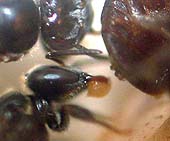 |
|
Austroplebeia bee depositing a drop of resin on the back of a Small Hive Beetle
|
Whenever Megan placed Small Hive Beetle eggs, grubs or adults in the observation platforms, the bees searched for any gaps in the seals of their hive and observation platform, and worked to seal them up. Megan concluded that sealing up gaps in the nest cavity is an important early defence strategy for these Austroplebeia bees.
Response to Small Hive Beetle Eggs and Grubs
When Megan placed Small Hive Beetle eggs in the observation platforms, the Austroplebeia bees were inquisitive and methodical. Some eggs were eaten by the bees and others were covered with resin droplets. Overall 90 to 97% of the eggs were destroyed within 90 minutes of being placed in the platforms. Mature Small Hive Beetle grubs are 11 mm long – over twice as long as an Austroplebeia australis bee. When Megan placed a mature grub in an observation platform, a group of bees attacked it. However, they were not able to coordinate a consistent defence strategy. For example, one bee would drag the grub towards the entrance then another bee would drag it back. Finally the grub died from the constant tug of war. Fortunately most of the grubs the bees would encounter in natural situations would be smaller younger ones, so Megan focused her further studies on these smaller grubs.
Megan placed 10 three-day-old Small Hive Beetle grubs in the observation platform on each of the four hives. Individual bees could pick up these 8 mm grubs independently and successfully removed 63% of the grubs within 15 minutes. Megan repeated the experiment and this time the bees improved their performance, with 93% of the grubs being removed within 15 minutes.
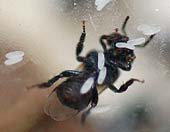 |
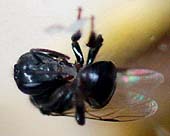 |
|
Top: Austroplebeia bee inspecting Small Hive Beetle eggs. Above: A bee eating a Small Hive Beetle egg.
|
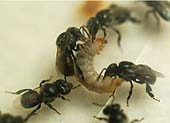 |
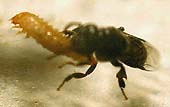 |
|
Top: Several bees wrestling with a mature beetle larva. Above: One on one: effective removal of a three-day-old beetle larva
|
Response to Small Hive Beetle Adults
Whenever Megan placed an adult Small Hive Beetle in an observation platform, it was attacked by five to six bees that grappled it, rode it and bit it en masse. As time passed increasing numbers of bees joined the fight, with up to 45 bees attacking a single beetle. The bees also daubed the beetle with resin droplets and pieces of soft cerumen from the nest structure.
Sometimes the bees drove the adult beetles out of the entrance. At other times, the bees would work to entomb the beetle alive with pieces of resin and cerumen, cementing it into the nest structure! Twenty four hours later, most entombed adult beetles were still alive but totally immobilised and of no threat to the colony. However, after 60 hours all the entombed beetles were dead and some had been beheaded by the bees. Out of 32 adult beetles placed in the observation platforms, the bees ejected 59% within four hours and the remaining 41% were entombed within six hours.
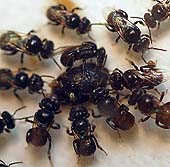 |
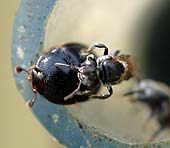 |
 |
|
Top: Mass attack on a Small Hive Beetle intruder. Middle: An Austroplebeia bee riding a Small hive Beetle as she drives it out of the hive entrance. Above: Using resin (bee on left) and cerumen (bee on right) to immobilise a Small Hive Beetle.
|
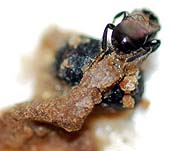 |
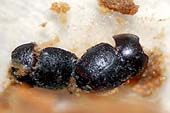 |
|
Top: A bee guarding an entombed Small Hive Beetle. Above: Two beetles that were beheaded by the defending bees.
|
At the Hive Entrance
Megan also tried introducing adult Small Hive Beetles into the hive entrances to test the bees’ guarding behaviours. (A small metal mesh was used to prevent the beetles from entering the hive itself.) Initially only two or three bees were guarding the entrance hole with a further two or three bees further inside the entrance. However, after Megan began introducing adult Small Hive Beetles, the number of guard bees increased and some armed themselves with resin balls on their hind legs.
Initially the guards succeeded in ejecting only 25% of the beetles from the entrance. However, as Megan continued the experiment and the bees became more experienced, 85% of the beetles were ejected.
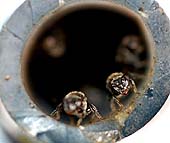 |
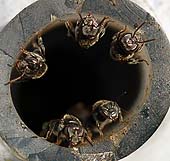 |
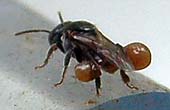 |
|
Top: Low numbers of hive entrance guards before the experiment. Middle: Reinforcements brought in to defend the entrance against Small Hive Beetles. Above: An Austroplebeia bee with her arsenal of resin balls on her legs.
|
Austroplebeia bees also normally close their nest entrance with a lacy resin curtain during the night. The bees erect this curtain in the late afternoon; then remove it as the day warms up in the morning. This curtain could be another effective protection for Austroplebeia bees against Small Hive Beetles because adult beetles, seeking new nests to infest, tend to fly at around dusk. Unfortunately Megan was not able to study this possible defence because her bees did not build resin entrance curtains during the time they were housed in the constant temperature rooms.
Good News for Austroplebeia australis Stingless Bees
Megan Halcroft’s research highlighted how important a sealed nest cavity is for Austroplebeia bees. Every time the beetle eggs, grubs or adults were detected by the bees, they immediately strove to close up all possible gaps in their hive seals. Megan recommends that stingless bee hives be closed and sealed as quickly as possible, if opened for hive splitting or honey harvesting. Megan suggests that doing these procedures inside an enclosed room or shed would greatly reduce the chance of Small Hive Beetles invading the hive.
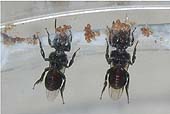 |
|
Two Austroplebeia bees hard at work sealing up the lid of the observation platform on their hive
|
Nevertheless, Megan’s research brought good news overall about the ability of Austroplebeia australis to defend itself against this destructive new pest. The bees quickly destroyed nearly all of the beetle eggs placed in the observation platform; they ejected most small beetle grubs within 15 minutes; and they ejected or entombed in resin all adult beetles within six hours.
Megan concluded that strong healthy colonies of Austroplebeia australis in undamaged hives would be able to defend themselves against invasion by African Small Hive Beetles.
|
All photographs of bees and beetles in this article were by Megan Halcroft, University of Western Sydney
|
Further Reading
Peter Neumann and Patti J Elzen (2004). The biology of the small hive beetle (Aethina tumida, Coleoptera: Nitidulidae): Gaps in our knowledge of an invasive species. Apidologie 35: 229-247.
William Michael Hood (2004). The small hive beetle, Aethina tumida: A review. Bee World 85(3): 51-59.
Mike Brown and James Morton (2003). The small hive beetle, a serious new threat to European apiculture. CSL National Bee Unit, UK. http://beebase.csl.gov.uk/pdfs/SHB_factsheet.pdf
(If you have not used PDF before, click here.)
• For more interesting Aussie Bee Online articles on native bees, visit the contents
Author: Anne Dollin
(See Anne Dollin's Google+ profile)
|
Please feel free to print out this article or to email copies of the PDF version to your friends. This article may also be reproduced or hosted on other websites providing it is kept in its full and unaltered form including ANBRC contact details.
|
.
Search Aussie Bee Website:
© 1997-2018 Australian Native Bee Research Centre
PO Box 74, North Richmond NSW 2754, Australia